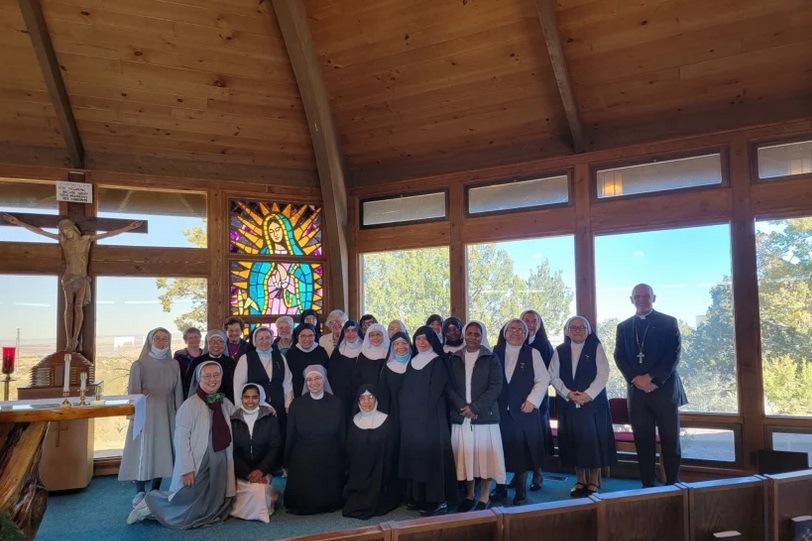Largest Native American diocese takes unique approach to synod
Unlike most dioceses in the U.S. that have turned to one or two key people to lead their synodal process, Bishop James Wall of Gallup has taken a different approach - by turning to one of the diocese’s religious communities to take the helm.
Dec 17, 2021

By John Lavenburg
Unlike most dioceses in the U.S. that have turned to one or two key people to lead their synodal process, Bishop James Wall of Gallup has taken a different approach - by turning to one of the diocese’s religious communities to take the helm.
“We’re a diocese with very limited resources. So, rather than hoisting this on one person’s shoulders, I thought it would be a little more doable if we were to ask the [Sisters of Our Lady of Guadalupe] religious community,” said Bishop Wall. “Plus, they’re awesome and everybody loves them. They’re also perfectly bilingual in English and Spanish.”
The decision, an uncommon one, provides a snapshot into the unique circumstances Wall faces in the Diocese of Gallup as the synod gets underway with the nation’s largest diocesan Native American population, COVID-19 and a perennial lack of resources.
The Diocese of Gallup spreads across 55,000 miles in Northeastern Arizona and Northwestern New Mexico. In addition to the diocese being split across two states, which presents its own challenges with state-bystate COVID-19 regulations, it’s one of the poorest in the country, though Wall said money “shouldn’t hold them back.”
The Diocese of Gallup also has the largest Native American population of any diocese. There are four pueblos and three traditionally nomadic tribes – the Navajo, White Mountain Apache, and the Jicarilla Apache. Like states, each reservation has its own COVID-19 regulations that Wall said are predominantly stricter than most of the country due to the disproportionately higher impact of the virus.
“The number of deaths we had due to COVID-19; it’s so shocking, so they’re being very, very careful,” Bishop Wall said. “We’re still in the middle of experiencing the effects of the pandemic.”
For that reason, Bishop Wall is one of the few bishops who still extends a diocesewide dispensation from the obligation to attend Mass. Some diocesan parishes still have 25 per cent or 50 per cent capacity limits in place. Therefore, Bishop Wall acknowledged that the situation in certain areas of the diocese may force the synod to conduct listening sessions to Zoom.
“It’s not the ideal situation, but what can we do?” the bishop said. “And if that’s what we have to do to keep people safe that’s how we have to do it because we want to make sure that we participate and everybody who’s Catholic has a voice in this process.”
The Diocese of Gallup launched its diocesan synodal process – part of the global Synod on Synodality launched by Pope Francis on October 10 – a little late, on Oct 24. Like the diocese itself, the way Bishop Wall has structured the synodal process is unique compared to other dioceses.
The prelate structured the process around the Holy Family with the Virgin Mary, St Joseph and Jesus each representing one of three diocesan synodal phases: listening, discernment and mission. They’ve even adopted a synodal icon for the diocese that depicts three hearts, one for each member of the Holy Family.
“The heart of Our Lady was the first phase that we’re in right now because she has that listening heart,” the bishop said. “The heart of St Joseph represents when we’ll be discerning, and then finally the heart of Our Lord, which represents our mission and what we’re called to do, which is really to proclaim the good news and the love of God.”
He noted that the goal of the phased approach is to make the synod more process oriented, as opposed to presenting it as “another programme” for parishioners to participate in. The listening phase of the synod the diocese is in right now is split into two parts.
The listening sessions between Bishop Wall and the parishioners won’t start until after the new year. In the meantime, the bishop has asked the entire diocese to pray “for the outpouring of the Holy Spirit.”
“It has to begin with the Holy Spirit, and then that allows us to listen to one another,” Bishop Wall said. “Right now we’re in that beginning stage, and we’re inviting the entire diocese to pray for the outpouring of the Holy Spirit, so that we can not only hear the Holy Spirit but also hear one another.” --Crux Now







Total Comments:0